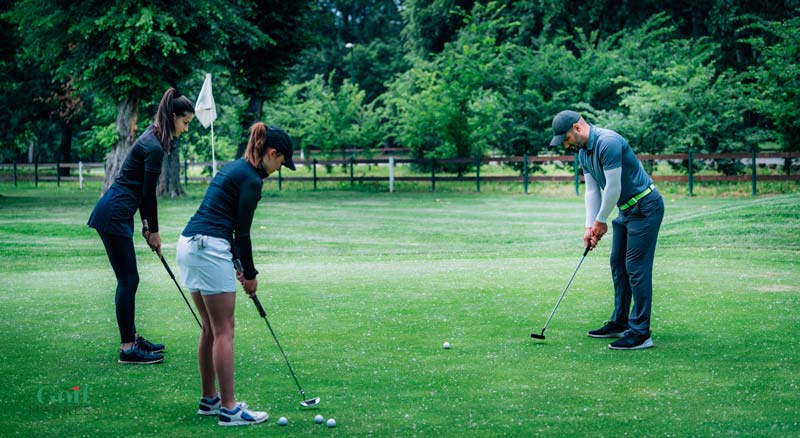
How Do You Stop Three Putting In Golf - Top 7 Tips
If you’re a golfer, then you’ll know all too well about the agony of three-putting and what it can do to your round. You could be on the verge of a personal best score, but a three putt on the final green sees it slip away. You may feel like you’ve made significant improvements in other areas, though your scores aren’t getting much better because you’re being let down by three putting on a regular basis. So how do you stop three putting?
How to stop 3-putting?
As golfers, we want to make less putts, as less putts lead to improved scores. At the end of the day, regardless of level, that’s what we all want.
To make fewer putts we need to cut out the occasions where it takes us three putts to sink the ball, or at least cut down on those occasions. Let's take a look at the different ways, or rather the different things we can do to stop three putting. Here's my list of top 7 tips:
Tip 1 - Find a consistent putting set-up
If you’re going to stop three putting, cut down on three putts or just be somewhat useful on the greens in general, then you need to find a putting set-up that works for you. It needs to be a consistent set-up, one that you can put into action every time you stand over a putt.

Far too many amateur players don’t have a consistent putting set-up, which is why their putting can often go from steady to erratic. You’ll see players who set up for one putt and then do something completely different for the next putt, before chopping, changing and doing several different things throughout the course of a round. An inconsistent set-up breeds inconsistent and often displeasing results.
Naturally, amateur golfers aren’t going to perform with the consistency of a professional. But if they can find a putting set-up that works for them, practice it, and use it every time, then they will start to see better results with the putter.
Tip 2 - Find a consistent putting stroke
Just like you need a consistent putting set-up, you need to find a consistent putting stroke. Again, it’s all about consistency.
If the way you stroke the putter changes from green to green, how can you expect to cut down the number of putts you make in a round and ultimately stop three putting?
The best way to develop a consistent putting stroke is to practice. Get on the putting green, try different things out, see what works best for you and stick with it. You can even practice putting from home. If you're curious how, read more about it in another article HERE.
What you don’t want to forget is that with the putter, it’s a stroke, not a shot. You don’t need to be swinging the putter too hard, nor do you need to grip too tightly. It’s important to grip the putter lightly to maintain the desired rhythm and tempo.

Tip 3 - Equate distance with stroke size
Many amateur players think that to stand a chance of making a really long putt, they must hit the ball really hard, only to realise that they’ve massively over done it after they see their ball whoosh past the hole, sometimes leaving the green!
It’s critical to remember that the distance of a putt is directly related to stroke size. You don’t need to move the putter more ferociously, nor do you need to hit the ball really hard, you just need to adjust your stroke size. For example, short putts require a short stroke, long putts require a long stroke.
The tempo and rhythm remains the same. Don’t stroke the putter harder, simply change the stroke size depending on the distance that needs to be covered.
Tip 4 - Pick a line and commit to it
Far too many players don’t pick a line, and this is often because they don’t really make an effort to read the green. To make putts, and more importantly, to cut down on or avoid three-putts, you need to make a big effort to read greens, and once you’ve done that, you need to pick a line and commit to it.
When it comes to picking a line, you’ve essentially got three options. You can go left of the hole, right of the hole, or straight for the hole, sometimes referred to as a centre line. This is where things get a little more involved. And for some this isn’t what they want to do, but for those who desperately want to stop three putting, listen up.
Look at the cup (hole) and decide upon the angle of entry, which will help you determine the break of the putt. If it’s on a slope, the ball is probably going to move quite considerably either left to right or right to left.

Once you’ve picked your line and are ready to putt accordingly, this is when you need to pick something specific to focus on, which is similar to picking an aggressive, small target when hitting an iron or approach shot. Find something like a particular blade of grass and focus on it.
Lastly, see the putt travelling on your intended line and entering the hole in your mind, focus on that image for a few seconds, and then hit the putt feeling confident that you’ve done everything right. Putting this routine into place and sticking to it will yield better putting results.
Tip 5 - Focus on lag putting
For those intimidating longer putts, you want to have aggressive targets, sure, but you don’t want to be too aggressive in the way you stroke the putter. A good way to stop three putting is to focus on lag putting. In other words, make the putt whilst thinking that getting down in two is great.
It’s kind of like a shot-to-nothing in snooker, which is when a player attempts to make a difficult pot but with safety in mind. You want to make tough long putts, of course, but you don’t want to overdo it and leave yourself in a really tricky position, because that’s when the three-putt occurs.
Of course, if you’re stood over a really drainable putt, then you’re not going to think about lag putting, but if you can putt with two putts in mind when standing over those longer ones, you might not one-putt with great regularity, but you will two-putt more consistently, and two putts are much better than three.
Get to a position where you’re two putting a lot more than you are three putting and your scorecard will reflect it.
Tip 6 - Think about your approach
Often, believe it or not, three putting is a result of something you did before you’ve even walked onto the green.
Many amateur players don’t put enough thought into their approach shot, which means that they’re often left in poor positions, even if they are on the green. This is often connected to bad decisions connected to course management and golf strategy (if hopefully they have one).
This leads to hitting putts that they’re not confident of making, and this negativity breeds poor putting. Players often drastically under hit or overhit their putts in this position, which is another big reason why three-putting is so common amongst amateur players.
More thought on approach can lead to less tricky putts, which in turn can lead to greater confidence from the moment you step onto the green, which ultimately leads to fewer three putts. The bottom line here is to think more about your approach, think where you do and don’t want to be on the green, and this should aid your quest for less three-putts.

Tip 7 - Practice, practice, practice
What’s that age-old saying? Practice makes perfect? Yep, that’s the one.
It’s cliche and a little bit cheesy, but when it comes to golf, it works. Those players who make the effort to focus on their game and practice regularly, for the most part, get better results than those who do not. It really is that simple.
To those with little golfing experience putting may seem like the simplest part, but us golfers know that’s not true. What it can be, though, is the most rewarding part of the game, as ultimately, on the greens is where you score.
Conclusion
There’s lots to remember and lots to put in place if you want to improve your work with the putter and thus stop three putting, so you need to put the work in. Get on the practice greens, practice your set-up, get to a point where you can easily set up the same way each time. Work on your stroke, make sure it’s consistent. Practice reading different types of putts, practice picking a line and committing to it.
Learn about what’s important, make the effort to improve all aspects of your putting game, find an approach that works for you, and stick to it. Doing this will not only get you closer to eliminating three putts, but it might just turn you into a putting superhero!😊


